White armor and colored armor ... (part two)
A still from the film by Lawrence Olivier “Richard III”: as you see, Richard was “attached” with a more reliable “chin-rest”, but ... they completely forgot about shoulder pads and bespoke - the “protectors” of the axillary hollows.

Our “Soviet” Richard III from the film “Black Arrow” (1985) in this regard is overwhelmed by more confidence. Although without the "pyramids" on the shoulders, it would be quite possible to do without!
In Italy, wearing this raincoat with armor became so fashionable that Antonio Pisanello 1450 of the year on his painting canvas “St. George "depicted the saint not only in Milan armor with characteristic massive shoulder pads, but also put on him a cloak called jarniah. In 1476, such a cloak, worn over the armor, was worn by Duke Charles the Bold, and in it he died. Today, this cloak, which became the prey of the Swiss, is exhibited in the historical museum of the city of Bern, so that what is related to clothing in the movie “Secrets of the Burgundian Court” has been reproduced very accurately. Here with some details of the armor for some reason left the problem. This cloak is made of red satin, and with sleeves and puffs at the very shoulders, while tapering to the wrists. D. Edge and D. Paddock believe that, in general, nothing indicates that this cloak was designed to be worn with armor, but for some reason the duke put it on? And it is on the armor!

"St. George and St. Mary "painting by Antonio Pisanello.
It is interesting that in St. George in the picture of Pisanello, George closes his armor to the knees both in front and behind, but their shoulder pads are for some reason fixed on top of not only the cloak, but also the sleeves reaching to the elbow. I wonder how this could be implemented in reality? Well, and the saint is depicted in a hat, which is somewhat funny in our opinion, but, apparently, quite consistent with the trends of that time.
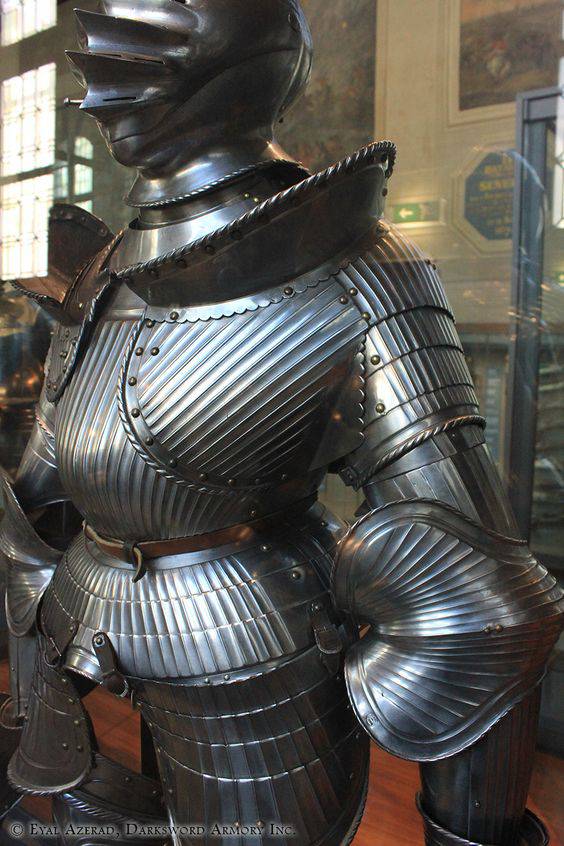
"Maximilian Armor" XIV century. Germany. Army Museum, Paris. Sample rationalism, taste and quality.
It is known, again, that methods such as chasing and metal carving for decorating armor were used in archaic Greece. But then they worked with copper and bronze. Now gunsmiths had to decorate iron, and it was much more difficult. That is why the earliest way to decorate such armor was their ... coloring! Moreover, it is clear that it is easiest to paint them with paint, but this technique was eventually considered primitive and began to directly paint the metal itself. First of all, or rather, before all gunsmiths mastered the technology of bluish bluing. At the same time, the Italian masters achieved such art in it that they could not only get a uniform color even on the largest products, but also get any desired shade. Violet and especially red (sanguine) hue were very much appreciated. They were able to give iron and elegant gray tone, which distinguished many famous inlaid Milan armor. Known black bluing, which sought, burning products in hot ash; Well, brown burnish became fashionable in Milan back in the 1530s. That is, the armor remained smooth and without any patterns, but ... "white" was no longer, but was "red", "brown", "black" and "blue."
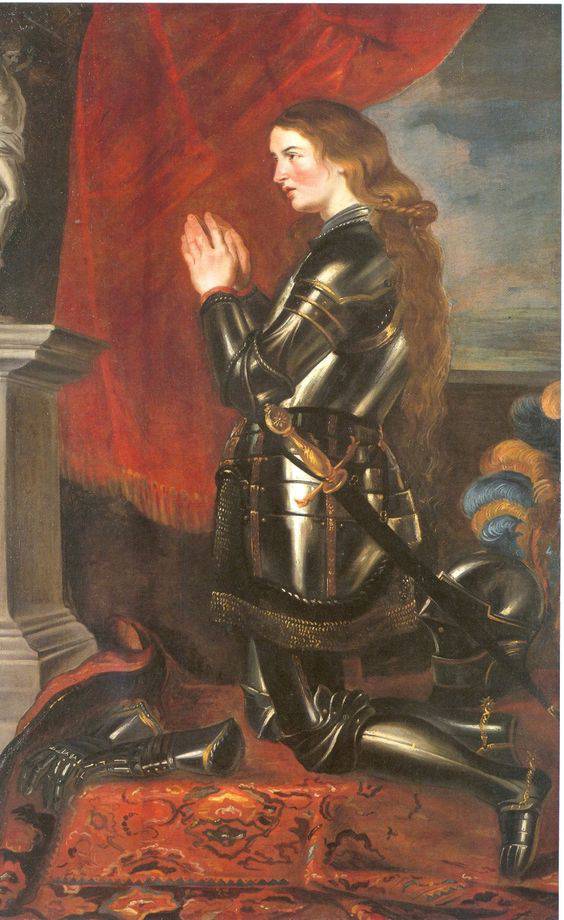
Joan of Arc. The painting by Peter P. Rubens, 1620, by Jeanne, is depicted in blued armor.
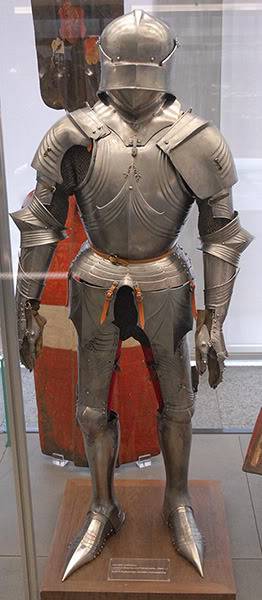
"White" Gothic armor. 1470 - 1480 German National Museum. Nuremberg, Germany.
Then in the middle of the 15th century, Italian masters began to use engraving to decorate armor, which from the 1580-s began to be combined with gilding. Gone as part of the armor, and all the armor entirely! The method was very simple, although very harmful. Gold was dissolved in mercury, after which, together with various additives, the resulting "amalgam" was applied to the product, which was heated over a fire. At the same time, mercury evaporated, and gold was very firmly connected with the base metal. For example, a very beautiful and at the same time solid gilding is visible on the Milanese armor of the work of the master Figino, made in 1560's.
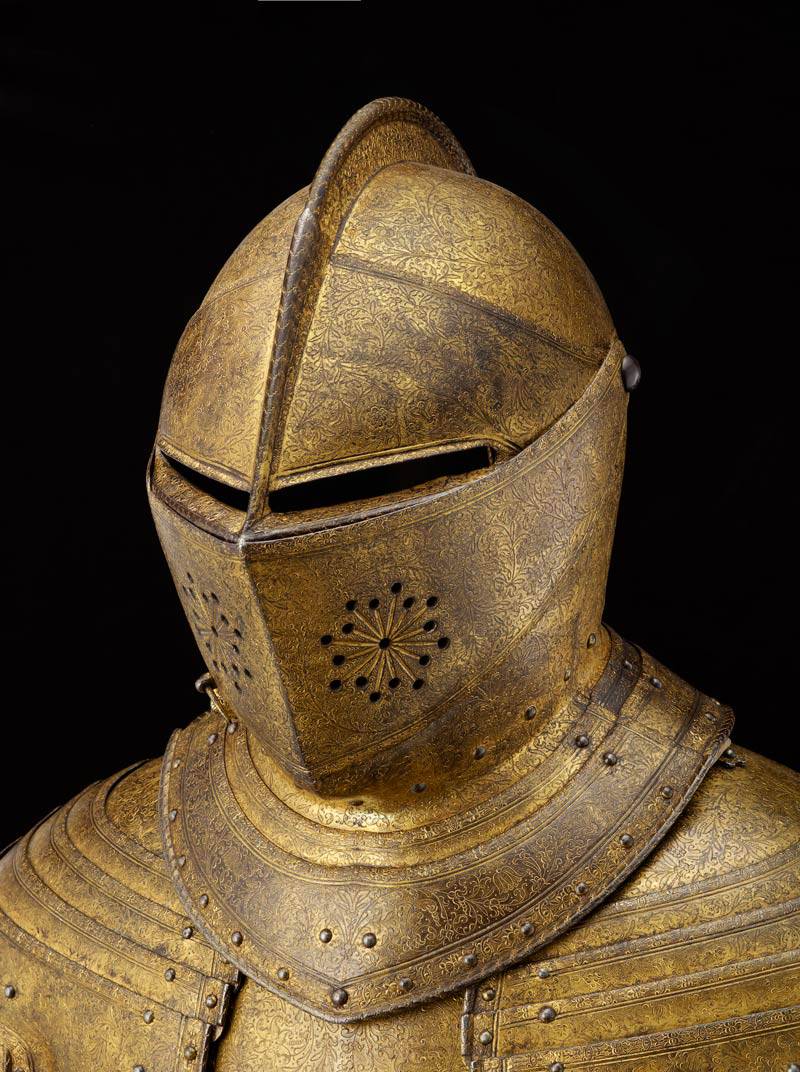
Gilded armor of King Charles I 1612 Royal Arsenal, Tower, London.
1570 Armor Royal Arsenal, Tower, London. Decorated with embossing and gilding.
At the end of the 15th century, they invented a method for decorating armor, which consisted in trimming them, as well as stripes and emblems that were made with acid etching. The decorative effect depends on whether the image on the metal is convex, and the background is deepened, or vice versa. In the first case, we see an image with a very flat relief, and in the second - something similar to an engraving on copper. But simply etching was rarely used. It was combined with blackening and gilding. When using pickling with blackening, the resulting cavities rubbed in a special “black” and caustic mineral oils, and then subjected the product to calcination. The oil evaporated and the "black" was connected to the metal. In the case of etching with gilding, the amalgam was rubbed into the grooves, followed by heating again followed by processing the product with files and polishing.
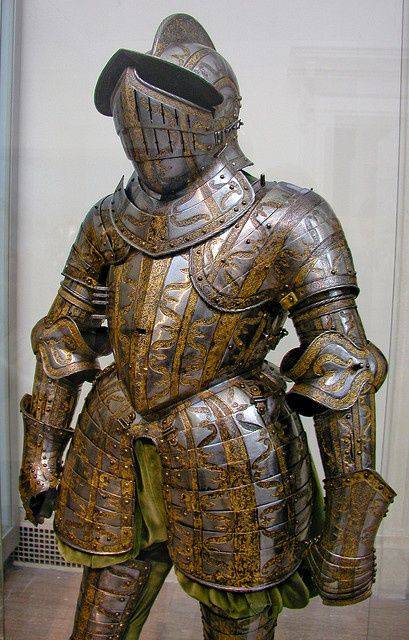
Parade armor of the XVI century. Metropolitan Museum, New York. Decorated and etched and gilded.
Actually, it was possible to decorate with such blackening not only depressions, but also the entire surface of the armor. To do this, use the "mobile", consisting of a mixture of silver, copper and lead in the proportion of 1: 2: 3, having the appearance of a dark gray alloy. They call such blackening “niello”, well, and its technology, like many other things, came to Europe from the East. And, by the way, it was only in the East that the helmets and shells were completely decorated with blackening. In Europe, this technique was mainly used by Italians; and already in the XVI century, its use was greatly reduced, giving way to cheaper blacksmithing.
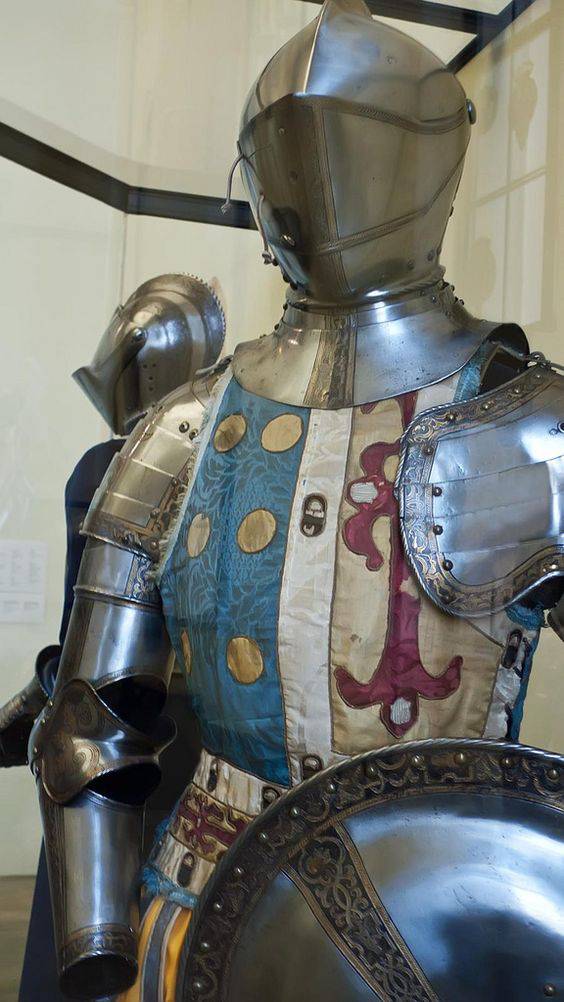
Parade armor with cuirass, covered with fabric, with the image of the emblem of their owner. Belonged to Don Sancho de Avila. Made in Germany in Augsburg at 1560, the Philadelphia Museum of Art, Pennsylvania, Philadelphia.
As for etching, this method was also very simple and therefore received very widespread in Europe. Its essence was that a special “paste” made of wax, bitumen and wood resin was applied to the surface of iron or steel, and then a picture was scratched on it. “Scratches” at the same time reached the metal itself, and the lines could be as very thin (for this they used needles), and quite wide. Then around the drawing they made a side of wax and, thus obtaining a semblance of a cuvette, “poured a special“ etchant ”into it. Usually it was a mixture of acetic and nitric acids, as well as alcohol. However, the "erudition" of the composition was not very important, because at that time no one was in a hurry. It was important to remove the composition from the surface of the product so that it does not pass through the metal. Then the “paste” was washed away, and the resulting pattern was corrected with a shtiheli or poisoned again to achieve a “game” of the reliefs.
At the beginning of the XVI century, when many German armor crowned to black and blue, a method of decorating them by etching by blackening appeared. In this case, the blued surface was covered with hot wax and, like with the usual acid etching, the picture was scratched on it - so that the metal was visible. After this, it was necessary to dip the product into strong wine vinegar, as if burnished, and a white polished metal was opened! After that, the wax was removed, and the light pattern on a black or blue background remained to please the eye. Sometimes it was also scraped with whip, and this technique was used until the XVII century.
A more secure, though expensive, gilding method was the forging method, which consisted in the fact that gold foil was superimposed on the red-hot surface of the iron product and smoothed by polishing. Known German armor 1510-ies from Augsburg, decorated in this way.
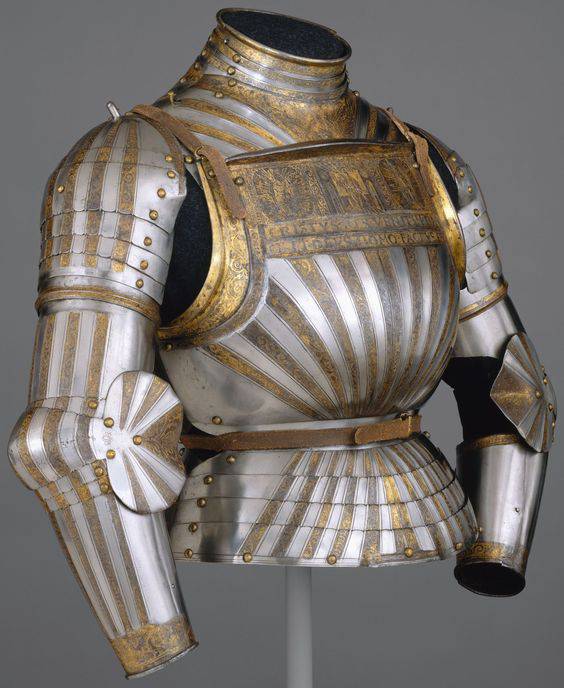
Armor 1510 Milan. Engraving needle and gilding. Weight 8987 Metropolitan Museum, New York.
A very ancient way to finish is inlay, taushirovka or "notch". In Italy, this technique spread in the 16th century as “lavoro all'Azzimina” or “alla Gemina”, both of which have Arabic roots. This technique was used in the West in ancient times, but later it was preserved by the Indians, as well as by the Persians and Arabs, who decorated the helmets and armor of the plates exactly like that. From them, this art passed to the Spaniards and Italians. Already at the beginning of the 16th century, the metal inlay technology was successfully used by masters of Toledo, as well as Florence and Milan, from where weapon Inlaid in Europe. The essence of the method is well known and consists in the engraving of an ornament on metal, after which small pieces of gold or silver wire are hammered into the grooves made by the chisel. Then the metal product undergoing the “notch” is heated, and the inlay is securely connected to its base. There are two types of such inlays: flat, flush with the surface of the product, and embossed, that is, protruding above it. The latter, of course, is much more complicated, since the protruding parts need additional processing, whereas a flat inlay is quite sufficient to process with a file and polish. By the way, after that, the iron can be painted in gray or blue, but in gold or silver, this color will not fall! However, this technique is laborious, and therefore very expensive, which is why it is used on relatively small surfaces.
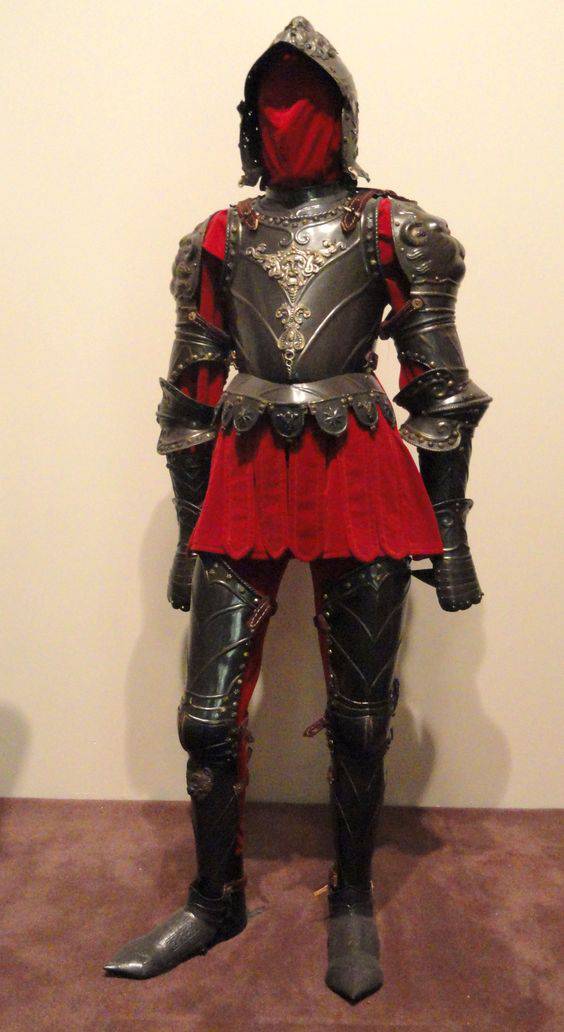
Chased parade armor 1500 - 1600 years. from Italy. Arsenal Higgins. Worcester, Massachusetts.
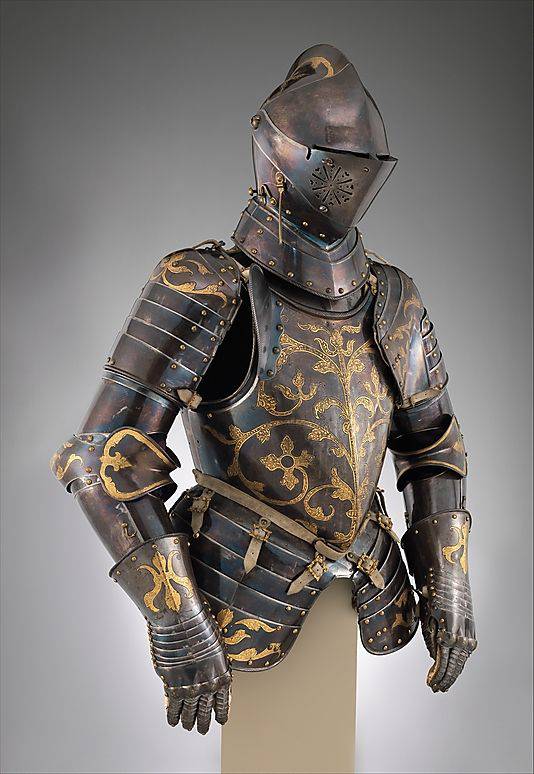
Relief "notch" on the metal. Armor for the duel of prince Christian I of Saxony. Metropolitan Museum, New York.
Also in the second half of the 15th century, such a method of finishing armor as iron embossing appears. It is clear that even the Indians of the Copper-Stone Age in America knew her again. But they minted for copper. The characteristic hardness for iron greatly impedes this method of processing. But as soon as large surfaces appeared on the armor, the idea of subjecting them to chasing took possession of the minds of many gunsmiths.
The difficulty lies in the fact that, unlike copper or silver, iron for chasing must be heated. A rough treatment is always started from the reverse side, extorting the general plastic form, and the thin one is carried out both from the front and from the reverse side, due to which this technology has received the French name “repoussé” - “counter-shock”. But then the technology became the common heritage of European masters, so that chased works are known in Milan, and in Florence, and in Augsburg.
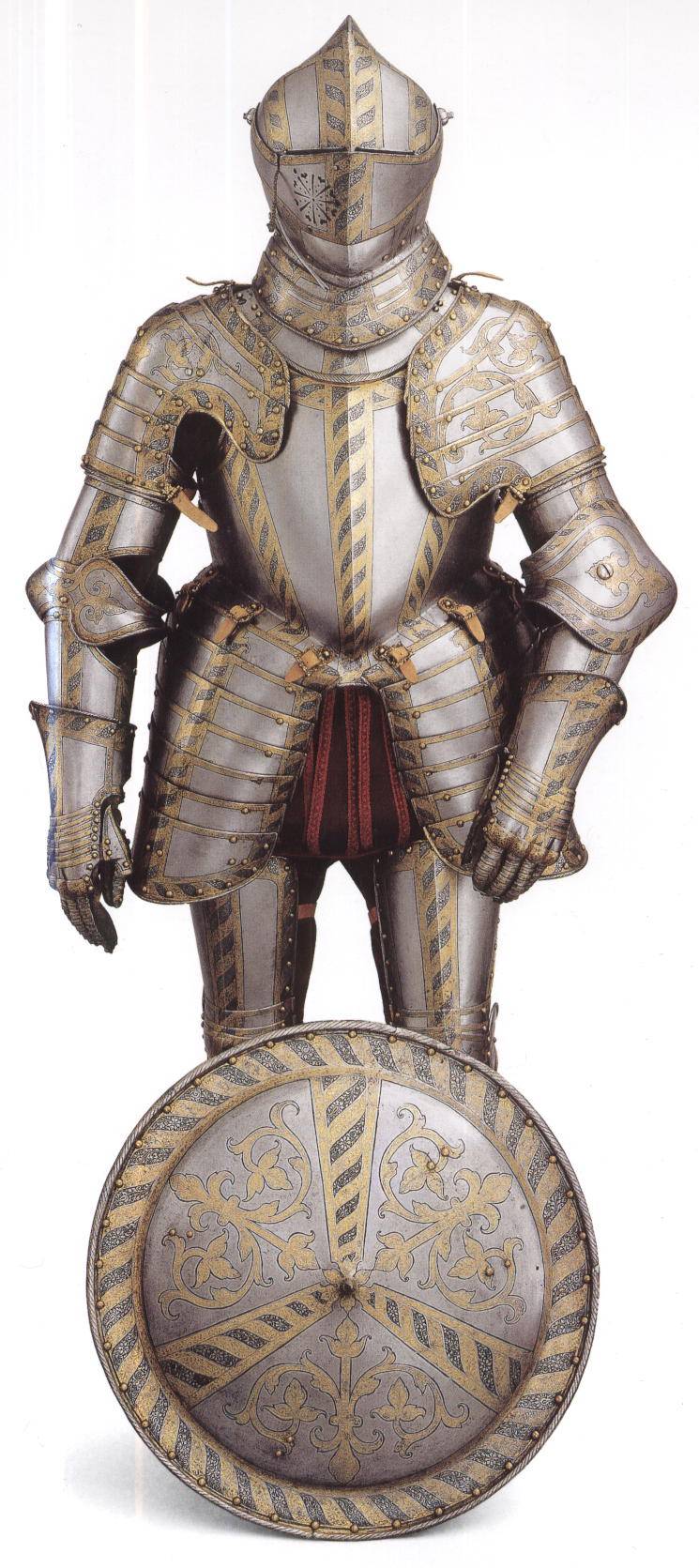
Parade-rifle armor with a round shield-rondasch Friedrich Wilhelm I, Duke of Sachs-Altenburg, Augsburg 1590, the Royal Arsenal, the Tower.
There is also a carving on the gland. Here, the work is carried out using shtiheli and cutter. And this technique was also used to decorate armor and weapons. Italy was here ahead of other European countries and in the XVI century overtook them all. Although in the XVII century French and German masters appeared, surpassing the Italians in the beauty of their products. Embossing was used mainly in the manufacture of sheet metal armor, and carvings on iron and other metals were decorated with swords, swords and daggers, gun locks, barrels, stirrups, horse mouthpieces, etc. Coinage, like carving on iron, was widely used masters from Milan, as well as Florence, Venice, and later became widespread in Augsburg and Munich, and combined with inlay and gilding. Spanish gunsmiths of the beginning of the 17th century combined stamping and carving with gilding, and the motifs of their ornaments were not too rich, which indicates the beginning of the decline of this type of craftsmanship.
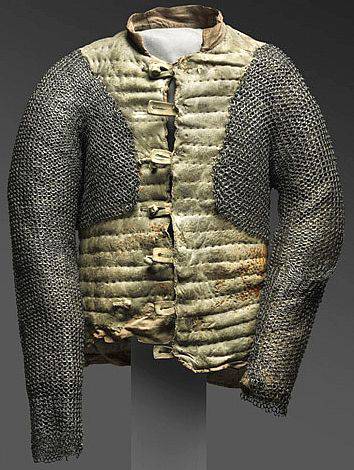
The hauberk, even when it was no longer used as a solid armor, continued to be used for a long time in such well-made patches that were worn under solid-forged armor. All that they did not cover was closed chain mail and, moreover, it did not restrain movements! Philadelphia Museum of Art, Pennsylvania, Philadelphia.
This is how it looks in the 2005 movie about Joan of Arc of the Year. It was precisely the early cuirass that consisted of two parts, both in front and behind, and they were fastened with straps. They used to wear only the lower part, and the top was covered with a cloth or chain mail.
Finally, perhaps the most luxurious type of decoration of armor and at the same time the most unnecessary is enamel. Enamel art appeared in the early Middle Ages and was widely used in jewelry, but for a long time it was not used by gunsmiths. However, in the early Middle Ages, cloisonne enamel was used to finish the handles of swords and shield parts. Later, it was useful for finishing the hilt of the swords, and on the sheathing of the scabbard, and such production centers were Limoges in France and Florence in Italy. Well, enamel in the 17th century was used mainly as decoration of the butts of richly decorated guns, and on the flasks.

Polish hussar helmet, decorated with a slit pattern, the end of the XVII century. Fitzwillam Museum.

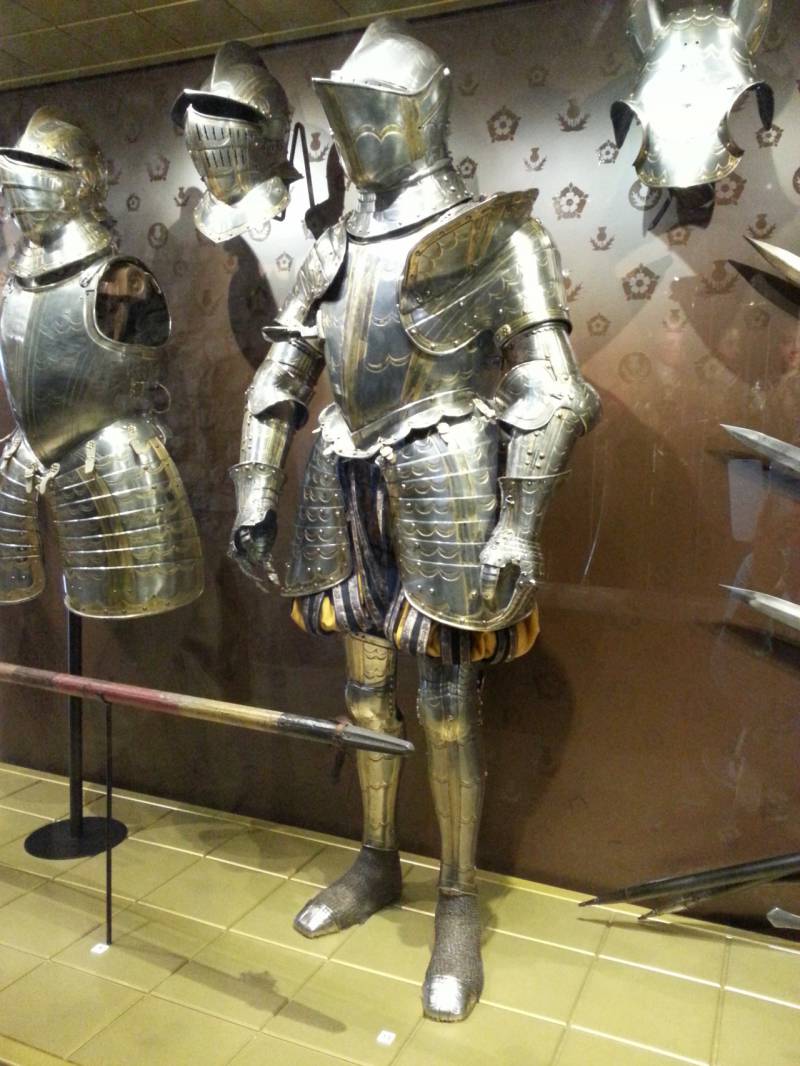

Information